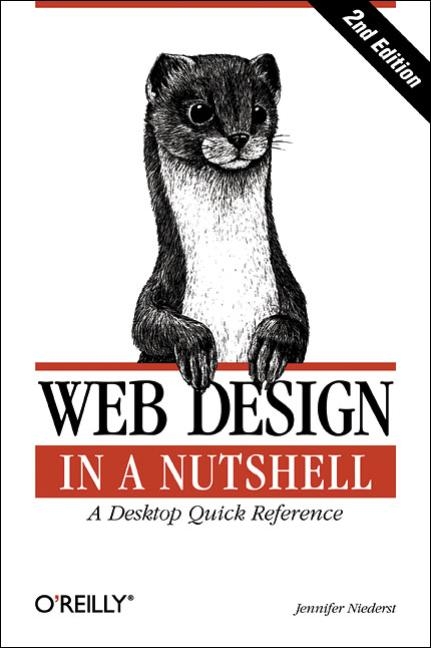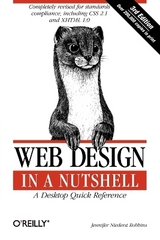
Web Design in a Nutshell
O'Reilly Media (Verlag)
978-0-596-00196-4 (ISBN)
- Titel erscheint in neuer Auflage
- Artikel merken
"Web Design in a Nutshell" provides access to the wide range of technologies and techniques from which Web designers and authors must draw. It is a reference for HTML 4.0 tags (including tables, frames, and cascading style sheets) with special attention given to browser support and platform idiosyncrasies. The HTML section details strange behaviour in tables, for instance, and gives ideas and solutions for using tables and frames on your site. This book also covers multimedia and interactivity, audio and video, Dynamic HTML, XML, embedded fonts and internationalization. It includes: discussions of the Web environment, monitors, and browsers; a complete reference to HTML and Server Side Includes, including browser support for every tag and attribute; chapters on creating GIF, JPEG and PNG graphics, including designing with the Web Palette; information on multimedia and interactivity, including audio, video, Flash, Shockwave, and JavaScript; detailed tutorial and reference on cascading style sheets, including an appendix of browser compatibility information; appendices detailing HTML tags, attributes, deprecated tags, proprietary tags and CSS compatibility.
Jennifer Niederst was one of the first Web designers. As the designer of O'Reilly's Global Network Navigator (GNN), the first commercial Web site, she has been designing for the Web since 1993. Since then, she has been working almost exclusively on the Web, first as creative director of Songline Studios (a subsidiary of O'Reilly) where she designed the original interface for WebReview (webreview.com), and as a freelance designer and consultant since 1996. She is the author of Designing for the Web (O'Reilly, 1996), and has taught Web design at the Massachusetts College of Art and the Interactive Factory in Boston, MA. She has spoken at major design and Internet events including the GRAFILL conference (Geilo, Norway), Seybold Seminars, and the W3C International Expo. You can visit her site at http://www.littlechair.com/ or send her email jen@oreilly.com.
Preface. Part I. The Web Environment. Chapter 1. Designing for a Variety of Browsers Browsers Browser Usage Statistics Design Strategies Knowing Your Audience Test, Test, Test! The Importance of Standards. Chapter 2. Designing for a Variety of Displays Dealing with Unknown Monitor Resolutions Fixed Versus Flexible Web Page Design Designing "Above the Fold" Monitor Color Issues Alternative Displays. Chapter 3. Web Design Principles for Print Designers The Web Is Not Like Print Typography on the Web Color on the Web Graphics on the Web. Chapter 4. A Beginner's Guide to the Server Servers Unix Directory Structures File Naming Conventions Uploading Documents (FTP) File (MIME) Types. Chapter 5. Printing from the Web Browser Print Mechanisms Printer-Friendly HTML Pages Cascading Style Sheets for Printouts Portable Document Format (PDF) Flash Printing. Chapter 6. Accessibility The Web Accessibility Initiative (WAI) Accessibility in Web Technologies Accessibility in Tools. Chapter 7. Internationalization Character Sets HTML 4.01 Language Features Style Sheets Language Features For More Information Part II. Authoring. Chapter 8. HTML Overview The HTML Standard HTML Tags Information Browsers Ignore Document Structure Tips on Good HTML Style HTML Tools HTML Resources in This Book. Chapter 9. Structural HTML Tags Summary of Structural Tags Setting Up an HTML Document Global Settings with the Tag Using Tags. Chapter 10. Formatting Text Summary of Text Tags Working with HTML Text Inline Type Styles and The Tag Lists Text Layout Techniques with HTML Character Entity References. Chapter 11. Creating Links Summary of Tags Related to Linking Simple Hypertext Links Linking Within a Document Affecting the Appearance of Links Targeting Windows Imagemaps Non-Web Links and Protocols Linking Documents with . Chapter 12. Adding Images and Other Page Elements Summary of Object Placement Tags Image Basics The Tag and Its Attributes Horizontal Rules Embedded Media Files Java Applets. Chapter 13. Tables Summary of Table Tags Introduction to Tables Basic Table Structure Affecting Table Appearance Table Troubleshooting Tips and Tricks Standard Table Templates Multipart Images in Tables. Chapter 14. Frames Summary of Frame Tags Introduction to Frames Basic Frameset Structure Frame Function and Appearance Targeting Frames Inline (Floating) Frames Frame Design Tips and Tricks Chapter 15. Forms Summary of Form Tags Introduction to Forms The Basic Form () Form Elements New Form Attributes in HTML 4.01 Affecting the Appearance of Forms Demystifying CGI Chapter 16. Specifying Color in HTML Specifying Color by RGB Values Specifying Colors by Name. Chapter 17. Cascading Style Sheets Using Style Sheets How Style Sheets Work Selectors Specifying Values Properties Positioning with Style Sheets What's New in CSS2 Style Sheet Tips and Tricks Browser Support Charts. Chapter 18. Server Side Includes How SSI Is Used SSI and the Server Adding SSI Commands to a Document Using Environment Variables XSSI SSI Commands Include Variables Time Formats for SSI Output Part III. Graphics. Chapter 19. GIF Format GIF87a Versus GIF89a 8-Bit Indexed Color GIF Compression When to Use GIFs Tools Overview Interlacing Transparency Minimizing GIF File Sizes. Chapter 20. JPEG Format 24-Bit Color JPEG Compression When to Use JPEGs Progressive JPEGs Creating JPEGs Minimizing JPEG File Size. Chapter 21. PNG Format The PNG Story When to Use PNGs Platform/Browser Support 8-Bit Palette, Grayscale, and Truecolor PNG Compression Special Features Creating PNG Files PNG Optimization Strategies For Further Reading Chapter 22. Designing Graphics with the Web Palette Designing with Web-Safe Colors Converting to the Web Palette Web Palette Strategies Color Blenders Where to Learn More. Chapter 23. Animated GIFs How They Work Using Animated GIFs Browser Support Tools Creating Animated GIFs Optimizing Animated GIFs Part IV. Multimedia and Interactivity. Chapter 24. Audio on the Web Basic Digital Audio Concepts Using Existing Audio Preparing Your Own Audio Streaming Audio Web Audio Formats Choosing an Audio Format Adding Audio to a Web Page For Further Reading. Chapter 25. Video on the Web Basic Digital Video Concepts Compression Video File Formats Which Format to Choose Adding Video to an HTML Document For Further Reading. Chapter 26. Flash and Shockwave Using Flash on Web Pages Flash Power Tools Creating Flash Movies Adding Flash to a Web Page Integrating Flash with Other echnologies Flash Resources Shockwave for Director Adding Shockwave Movies to a Web Page Director Online Resources. Chapter 27. Introduction to SMIL How SMIL Works SMIL Players SMIL Authoring Tools Writing SMIL For Further Reading Part V. Advanced Technologies Chapter 28. Introduction to JavaScript JavaScript History JavaScript Basics Sample Scripts Handling Multiple Browsers. Chapter 29. Introduction to DHTML Using DHTML How DHTML Works The Document Object Model Creating Layers DHTML Examples Browser Detection DHTML Tools Where to Learn More. Chapter 30. Introduction to XML Background How It Works XML Document Syntax Document Type Definition (DTD) Examples of XML Technology Where to Learn More. Chapter 31. XHTML XHTML Standards Development Creating XHTML 1.0 Documents XHTML Document Declarations Well-Formed XHTML Try It Out. Chapter 32. WAP and WML About WAP Creating WAP Applications Introduction to WML WML Elements and Attributes WAP and WML Resources Part VI. Appendixes Appendix A. HTML Elements Appendix B. List of Attributes Appendix C. Deprecated Tags Appendix D. Proprietary Tags Appendix E. CSS Support Chart Appendix F. Character Entities Glossary Index
| Erscheint lt. Verlag | 23.10.2001 |
|---|---|
| Zusatzinfo | glossary, index |
| Verlagsort | Sebastopol |
| Sprache | englisch |
| Maße | 153 x 228 mm |
| Gewicht | 868 g |
| Einbandart | kartoniert |
| Themenwelt | Informatik ► Web / Internet ► Web Design / Usability |
| ISBN-10 | 0-596-00196-7 / 0596001967 |
| ISBN-13 | 978-0-596-00196-4 / 9780596001964 |
| Zustand | Neuware |
| Informationen gemäß Produktsicherheitsverordnung (GPSR) | |
| Haben Sie eine Frage zum Produkt? |
aus dem Bereich



